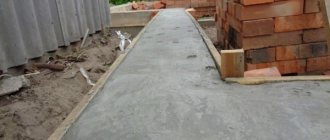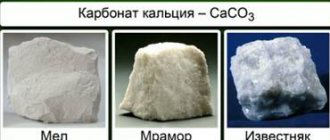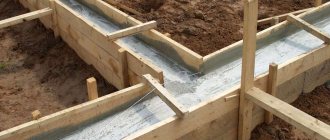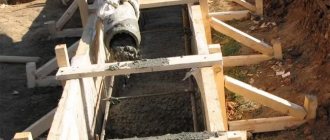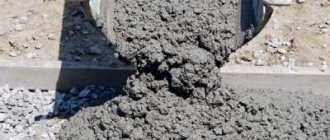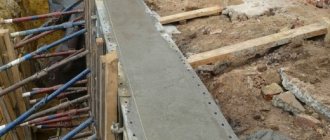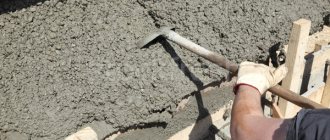The answer to the question of how long the foundation should stand before building a house depends on a whole range of factors: the structural features of the building, the depth of its base and the degree of heaving of the soil, temperature and humidity of the environment. The foundation should not be loaded before the safe and regulatory start date for work has passed, but it is also undesirable to leave it unloaded for the entire winter. What to do if such a need arises will be discussed in this article.
The strength of the foundation depends not only on the quality of the concrete, but also on the conditions of its hardening
Tape fill
There are two types of strip foundations: shallow and recessed.
The small version is used for light frame-type buildings made of wood beams or other lightweight materials. Often these are structures for technical purposes, such as a shed for equipment or an outdoor toilet. The lower edge of the structure is located above the groundwater flow level.
Approximately the same degree of pressure is exerted on the structure as on the grillage of a columnar building. If you need to wait before building a house, then definitely not from autumn to spring. Heaving of the soil from the cold, an increase in the amount of groundwater, and seasonal changes in the soil increase the risk of deformation of the fill.
Tape form
When the house is planned to be heavy, it is completely buried by 1.5-2.5 m; more accurate data depends on the depth of soil freezing. The base of the base must be below the line of soil moisture flow.
The pressure is distributed very deeply, evenly, and there are no points of unloading. The foundation shrinks under the influence of its own mass; by the time it dries completely, the process is completely completed. You can start working.
Features of strip foundation
Laying the foundation is a very labor-intensive stage of construction work. The strip foundation is laid under each outer wall of the building in the form of a continuous strip, as well as under load-bearing interior walls and is a high or not very high half-wall, depending on the depth of the laying.
The strip version is the most popular among other types of foundation. Depending on the method of construction and the materials used, the strip foundation can be prefabricated or monolithic:
- A monolithic foundation is erected directly on the building construction site, and there are two types depending on the expected weight of the structure - shallow and buried. Shallowly buried strip monolithic foundation is used in the construction of lightweight buildings on clay soils. A buried monolithic foundation is constructed in the case of the construction of heavy structures and buildings that include a basement floor, an underground garage or other basements on unstable soils.
- A prefabricated strip foundation is made up of blocks based on reinforced concrete, which are manufactured at the factory, transported by special equipment to the construction site and installed in trenches at the construction site using a crane. In terms of strength, a prefabricated foundation of this type is inferior to a monolithic one.
Characteristics and features of strip foundation
Strip foundation - the foundation of a house in the form of a strip, a strip located completely under all external walls and under some internal walls (for large building sizes).
The base of a reliable strip foundation must rest on a layer of earth where the soil temperature is always above 0°C.
The strip foundation can be made of a cement mixture and small crushed stone or rubble stone filled with ready-made cement mortar.
The strip foundation material is concrete and reinforcement. An iron frame made of pieces of metal reinforcement welded together is intended for use as a supporting skeleton that strengthens the concrete part of the foundation, distributing uneven loads throughout the entire base strip. A rubble strip foundation does not need such a frame.
But a tape made of small crushed stone and concrete, intended for a massive structure, must be reinforced with reinforcement. How long should the foundation sit after pouring is a question that many owners who are building their own country house ask themselves. How long should a strip foundation be allowed to stand in order to support the weight of the structure and not crack after the building is erected?
Requirements for strip foundations
Installation diagram of a strip foundation.
The main requirement for the design and materials of the building’s foundation is to ensure strength and durability. The foundation supports the wall, partitions, roof, ceilings, floors, furniture, heating system and plumbing. The depth of the foundation should prevent the house from swelling when the soil freezes in winter.
To do this, the base of a reliable foundation is rested on a non-freezing layer of earth at a depth where the soil remains warm (above 0°C). Frozen ground can expand in size, rising in winter and sinking in summer. The house will stand without raising or lowering if the foundation is properly constructed.
A strip foundation resting on a non-freezing layer of soil will ensure a long service life for your structure. Is it possible for a foundation in the form of a tape to shrink after its construction and under what conditions do shrinkage processes have the maximum impact on the foundation tape? How can you prevent or reduce the impact of shrinkage processes?
Shrinkage of concrete and soil settlement
Shrinkage is the process of reducing the size of a building material during the process of hardening and drying. It becomes noticeable some time after construction is completed. Shrinkage of concrete occurs during the process of hardening; according to building codes, the size of shrinkage in concrete is 1% of the wet mass.
Settlement is the process of the earth sinking after it has been dug up. Occurs over a period of time and intensifies after rain and getting wet.
Both of these processes accompany construction.
Depending on the amount of shrinkage and settlement, they can be compensated within the material or cause destruction of the building and its parts.
Shrinkage of concrete and soil settlement influence the possible subsidence of the strip foundation and the amount of time required for its settling.
What are the consequences of untimely removal of formwork?
As you know, a mushy concrete solution is used to fill a strip or slab foundation for a house. After laying it in the formwork, the processes of cement hydration and gradual hardening of concrete begin. To complete them correctly, you need to allocate a certain amount of time required so that the foundation can stand and gain design strength.
If the formwork is removed from the structure immediately after the cement has set, there will be a possibility of the monolith spreading in different directions. A fragile “body” will not only not be able to take loads, but also maintain its own shape. This is especially true for massive foundations.
If the dismantling of the formwork from a strip foundation is carried out after the cement mortar has set, but before it gains a certain strength, then cracks will appear in the structure. For the underground part of the house, which takes on and distributes all the loads onto the ground, this threatens to split and complete destruction already during the operation of the house.
How long should the foundation stand after pouring? There is no clear answer to this question. The average period of time is determined by 28 days, but in some cases 15-20 days are sufficient. In difficult conditions, the deadlines need to be extended.
Professionals assure that the foundation of the house must stand for at least a month before it is loaded.
To prevent the structure from shrinking, warping or collapsing, you must strictly follow the construction rules and technology for constructing the underground part of the house. The foundation is the support of the building, and therefore does not tolerate negligence, inability and lack of basic knowledge.
How long does it take for concrete to gain strength?
A concrete structure is an artificially created stone made from a mixture of sand, cement, water, sometimes with the addition of gravel and crushed stone. Strong structures are obtained after reinforcement - preliminary laying of a frame from reinforcement rods for filling with mortar.
The time required for complete drying can vary; the presence of additional additives, the climate of the area, the thickness of the pouring layer, and the number of layers of concrete matter.
The average indicator is 28 days, but in order to estimate the approximate time frame, you need to know exactly the proportions of raw materials in the general solution, temperature conditions, air humidity level, and the density of the mixture used.
The drying process of concrete consists of two main stages - setting and complete hardening.
Chemical processes
When making concrete, cement is used, which is intended to connect the components of concrete. Cement, entering into a chemical reaction with water, forms a solid rocky substance that connects sand and crushed stone.
The chemical processes occurring at the initial stage are called setting, during which the first bonds between the filler are formed in the concrete, and strength gain consists of strengthening these bonds.
For the normal occurrence of chemical reactions in concrete, the presence of water is necessary. The process of ripening concrete is long, and the water initially contained in the solution quickly evaporates, so the concrete is protected from rapid drying out of moisture, and for this purpose it is covered with roofing material or plastic film, or periodically moistened abundantly. To obtain a high-quality foundation, it is important to ensure that the concrete dries evenly.
Is it possible to make a foundation in winter?
When pouring the foundation in winter, the maturation of concrete is suspended, since the water necessary for chemical processes freezes. But this is not all the disadvantages of such installation; the water in the solution, freezing, will expand, and at the same time tear the concrete from the inside.
Practice and research show that already at minus 10°C, chemical processes in concrete slow down, and along with them, the process of strength gain slows down.
Therefore, when making a foundation in winter, after pouring, the concrete mixture must be heated throughout the entire maturation period. During individual construction, it is difficult to heat the foundation and this will entail additional costs, so it is advisable to make the foundation in the summer, at an average air temperature of 20 to 25°C.
How to reduce the maturation period of concrete?
Modern materials make it possible to change the maturation time of concrete; it is enough to use special additives. The use of additives allows you to obtain durable concrete in two weeks. Such additives have one significant drawback, which does not allow their use in individual construction. Additives shorten not only the ripening time, but also the setting time, and therefore when they are used, there is little time for pouring the foundation.
Another way to shorten the ripening period is to increase the ambient temperature, which is also problematic in individual construction.
Compliance with the maturing time of concrete will allow you to get a solid foundation.
After filling. The strength of a reinforced concrete foundation depends not only on the quality of the reinforcement and concrete. The monolith must still gain sufficient strength before walls can be erected on it. Let's try to figure out how long the foundation should stand before building a house.
Setting of the solution
The setting period of a concrete mixture is the length of time during which the solution remains sufficiently liquid.
You need to deliver the fresh mixture to the site, pour it, level it, and vibrate it.
It is possible to extend the life of the liquefied form if you use a concrete mixer to mix the components - the raw material will be in constant motion and will not have time to harden quickly.
State of the solution during pouring
You cannot overexpose the concrete in the mixer; as the mixing time increases, the original properties of the solution are violated, which will immediately affect the quality of the base being poured.
The warmer it is outside, the faster the concrete will set. The setting time is slightly extended if it has rained heavily outside - the air becomes saturated with moisture.
Carrying out concreting in the heat and cold is equally bad - the concrete will crack. The optimal temperature is 20 degrees.
Curing of concrete
When the concrete is already poured, strength begins to gain. Depending on the weather and days of waiting, different degrees of drying are noted.
Complete drying without leaving wet areas takes 28-30 days at 20 degrees Celsius. Percentage degree of hardening:
Table with data on the relationship between the temperature of the solution and the hardening period
To completely dismantle the formwork, it is necessary to wait until at least 70% of the brand strength is reached, but not earlier than 7 days after concreting (if a deeply buried foundation is laid). If it starts to get cold outside, the temperature drops to 10 degrees, you need to wait two weeks.
It is impossible to say exactly how long it will take for concrete to harden; the main component – cement – is of three types: fast-hardening, medium-hardening, and slow-hardening.
Table values for cement hardening speed depending on type
The only requirement remains - wait until 70% strength is reached, provided that the first days the fill is watered to ensure uniform drying.
Concrete maintenance work
Construction rules SP 70.13330.2012, which update the text of SNiP 3.03.01–87, require concrete to be cured and maintenance measures taken before stripping. Data on how long the concrete laid in the formwork that forms the contours of the foundation should sit is specified in paragraph 5.4.1 of the Rules.
All surfaces must be reliably protected from possible evaporation of the water contained in the solution. You should also protect the freshly laid concrete mixture from precipitation on its surface. Such measures must be carried out before construction for the entire period until a strength gain of at least 70% of the rated value is achieved.
After stripping, it is necessary to create conditions to maintain temperature and humidity at values that optimally correspond to the increase in strength of the concrete structure. The rules do not allow walking on the surfaces of concrete structures until the concrete reaches a strength of 2.5 MPa. Accordingly, it is forbidden to install overlying formwork, carry out brickwork, erect wooden walls and perform other construction or auxiliary operations.
What factors influence curing and pouring?
The foundation is the base of the house, which should evenly distribute the load of the building on the ground to prevent subsidence or collapse of the structure. The strength of the foundation is determined by its type and the materials used for pouring. The durability of the walls and the building as a whole depends on this. It also depends on the time given for the foundation to settle after pouring.
At the moment, the required amount of time allotted for the concrete to settle is determined by SNiP, however, SNiP only indicates the required period for certain standards, which do not always coincide with the actual conditions for a particular object. The period for settling the solution after pouring the foundation is influenced by the following factors:
- Ambient temperature and humidity.
- Presence/absence of precipitation.
- Soil type and condition.
- Terrain and depth of groundwater.
- Quality of materials and construction technology.
- Type of base.
- The type to which foundation waterproofing belongs.
Naturally, no regulatory act can take into account all of the above conditions, therefore, to determine the period of settling of the foundation, you should be guided primarily by your own knowledge and experience. To be sure that the foundation has stood, you should take the most negative conditions for the area in which construction is taking place, and, based on them, calculate the period.
At the same time, it is important to plan the construction so that by the time the temperature drops below +5 degrees Celsius (i.e. before the onset of autumn), the foundation is ready. Otherwise, it will need to be covered and insulated, and covering the base is a troublesome task, requiring additional resources. After the cold weather, many wonder why the uncovered base cracks? The answer is simple - from moisture getting into micropores, which, when hardened, breaks the concrete.
Moreover, if the climate, soil and topography cannot be influenced or changed, then the type of foundation is determined during construction, and the waterproofing of the foundation depends on the materials used and the quality of the work.
Basis for construction
The foundation is the basis of the entire structure of the house, so it must be strong, reliable and durable. If the foundation has defects, they will inevitably affect the entire structure of the house, so it is necessary to prevent their appearance at any stage: design, pouring, standing. The last stage still causes a lot of controversy among professionals; a huge number of misconceptions have formed about the time frame within which the foundation should be defended. Let's try to figure out how long it takes for concrete to dry and be suitable for building walls and laying floors at home.
The foundation is the basis of the structure, so its strength is most important.
The foundation is poured with concrete - a liquid solution, which, when dried, forms a solid and strong composition of high strength. But concrete is also a heavy substance that needs to sit until it dries completely. In addition, concrete tends to gain strength over time. In six months to a year, it completely reaches its design strength. But there is no need to wait so much time before building walls. According to SNiP 3.03.01-87, stripping of structures and subsequent processing of concrete is permissible when the latter reaches 70% of its design strength. With proper care and normal conditions, the foundation should stand for 5-8 days after the start of setting. That is, if the concrete has been standing for a week, you can invite specialists to measure what percentage of actual strength the concrete has gained. The resulting value is compared with the design value, and if it is at least 70%, there is no point in defending the house any longer.
Prolonged downtime of the foundation of a house is fraught with the risk of the pit becoming frozen, frost heaving, thawing or freezing of the soil. Rain, snow, frost, and winds will invariably cause damage to the structure, so the decision to winterize is very controversial and even undesirable. Soils are prone to so-called frost heaving, which puts pressure on the foundation. Not weighted down by the weight of walls and ceilings, it can move or form uneven shrinkage. Such a break to allow the structure to stand is fraught with serious consequences.
What time of year is best to lay the foundation?
Many people are concerned with the question of what time of year is best to pour the foundation. As a rule, the foundation is laid in the fall so that it can settle over the winter. But there are no strict recommendations regarding the time of laying the foundation. The main thing is that the soil is not frozen.
Again, everything has to do with the curing of the concrete. If there are no problems with this in the spring-autumn period, then in winter the water necessary for setting concrete can freeze. Because of this, the concrete does not gain the necessary strength. Antifreeze additives, of course, can save the situation, but still the best time of year to pour the foundation is summer or autumn.
The foundation is the main load-bearing structure that bears all the loads from the building. Its main task is to support the weight of the building. The foundation should not settle, warp or form cracks. Thus, reliability is the main requirement for a foundation.
The foundation will not become reliable if the technological rules for its manufacture and initial operation are violated. It is recommended to make a concrete foundation at an ambient temperature of at least + 5°C; this makes the work seasonal, otherwise the concrete will not fully set.
"Shelf life" of the foundation
How long can a foundation stand without a house? After all, you often see the following picture: the monolith was prepared, but further construction was frozen. After a couple of years, they decided to continue the process. But doubt arises about the safety of the structure.
If the foundation has been properly preserved - covered with floor slabs, waterproofed, and groundwater drainage measures have been fully implemented, there is hope that the structure has been preserved in proper condition.
If none of the above has been done, invite specialists for a technical inspection of the foundation. It is risky to build walls without checking its condition.
General recommendations on timing
The building code states that the foundation will gain full strength in 28 days.
Let's try to figure out the recommendations for how long the foundation of a house should last. If you lay the foundation for the winter, it will take, firstly, a lot of time, and, secondly, additional funds. You will have to protect the support from excessive exposure to moisture, and perhaps even dig a trench to drain melt and rain water along the internal and external perimeters. You will have to protect not only the base itself, but also the soil. This method is quite time-consuming and troublesome. There is so much to consider. But experts note that in the spring all possible deficiencies in the filling will manifest themselves, they can be promptly eliminated or the foundation can be completely redone, depending on how many deficiencies are discovered. However, refilling does not guarantee new flaws, and waiting another year to check the base is completely impractical.
The foundation has been built. Are we building walls?
Most likely, those who have taken on the construction of a house know or have heard that immediately after laying the foundation, you should pause before continuing construction. But not everyone understands why it is necessary to defend a strip foundation.
According to building regulations, any type of foundation must be settled before the construction of a building continues on its basis (with the exception of a pile-screw foundation). This is necessary so that the concrete dries completely, so that the structure does not sag in the future or crack, for example, in a wall. In a word, it was not deformed.
Why can this happen? The reasons for various types of defects are very diverse:
- incorrect trench depth for laying the foundation;
- low quality of the prepared concrete mixture;
- high humidity of the soil where the foundation was laid;
- season of the year and air temperature when laying the foundation and other reasons.
Start period for wall construction
Continued construction begins immediately after the concrete has sufficiently hardened.
The widespread information among craftsmen that you need to wait until the concrete has completely dried is not supported by standards in any way - it is a myth.
In addition to increasing construction time, there is a harm - settling is not the same as conservation; the concrete will remain exposed. The foundation will become unusable even before construction begins.
Wintering the foundation
There is an increased risk of concrete deformation on heaving soils that change in size in winter. If great pressure is not applied to the ground from the combination of the foundation and the house, the soil will squeeze out the structure, compromising the integrity of the structure.
If the reinforced fill freezes, destructive processes will not be visible immediately, but will begin after 12-24 months.
With sufficient density, the question of defending the structure is not raised - if the technology is followed, delaying construction does not bring significant changes.
Does the foundation have an expiration date?
The poured base can be left for a while, for example, if there is a lack of construction budget or a long departure. To preserve the concrete, conservation is carried out.
After pouring the concrete, you need to wait until it dries, cover it with waterproofing, insulate it, cover it with roofing felt, construction polyethylene in several layers on all sides, pressing it tightly.
When it is warm enough, around late spring, the preservative cover is completely removed, allowing the concrete to breathe until the fall. If construction needs to be postponed again, the steps are repeated.
Without protective cover there is no hope that the foundation will be strong enough for the approved plan.
If construction is suspended for a long time, before resuming it is necessary to invite a specialist to check the condition of the fill. You need to get a competent assessment; this determines whether the new house will stand.
The foundation is the basis of the structure and makes up only 10% of the total mass of the finished house. It is necessary to lay the foundation in accordance with the technology, the imposed requirements, and not leave it idle - the load-bearing potential must be used. Immediately after the filling has dried, you can begin to build the walls; the completed house can be left to stand before finishing.
How to preserve the foundation for the winter:
What to do if the foundation (soil) subsides?
If the shallow foundation was built incorrectly, the time required for the foundation to stand was underestimated, the concrete or wall broke, the structure can be corrected. How to do it? Possible options for such a major repair will depend on the size and number of cracks.
Reconstruction of a sagging foundation.
- For small, non-through cracks, you can strengthen the soil by adding crushed stone and sand on top of the subsidence near the cracks. However, if the destruction of walls or foundations continues, such a repair measure is insufficient.
- Foundation repair: for this, the soil is excavated and the foundation is deepened in places where it has subsided. A hole ranging from 0.5 m wide to 1.5 m long is dug near the surface of the crack propagation. The depth of the hole corresponds to the depth of the foundation being repaired, taking into account the size of the foundation recess. Since the concrete has already cracked, it is advisable to provide maximum deep supports under its base, and even better - to deepen the foundation (at least at intervals) to a non-freezing layer. The deepening work is carried out similarly to pouring: formwork boards are installed, rubble is laid, crushed stone is poured, concrete is poured.
- Repair of walls (if they have already been erected) is carried out by covering with cement mortar and plastering. At the same time, destruction indicators are established in the walls - cement rectangular inserts are placed on the outer surface of the repaired cracks, on which the date of repair is indicated. Continued destruction will be primarily noticeable on the surface of these rectangular inserts - microcracks will appear.
- If several cracks appear, the building can be wrapped with two strips of metal ties installed under the roof and above the plinth.
- As destruction continues, the structure is partially dismantled, the foundation is re-laid and new walls are laid.
The settling time of a strip foundation depends on its depth, the materials used when pouring and the seasonal time of construction.
Some general tips
To determine how long a strip foundation should last in your particular case, it is useful to familiarize yourself with some recommendations that will help you better navigate this issue. Already at the stage of preparatory work and laying the foundation of the future building, regulatory recommendations should be strictly followed. For example, before pouring, make sure that the sand cushion is thoroughly compacted, and the construction work itself is carried out in several stages, this will improve the quality of the foundation and reduce the likelihood of its deformation.
If a building of 2-3 floors is being erected, then according to the standard, the time for complete hardening of concrete is 46 days. To be completely sure, when carrying out work in the autumn-winter period or due to the not entirely satisfactory quality of the concrete or cement brand, the curing time can be extended to 60 days.
When the first floor is erected, work is suspended for 7-10 days, allowing the foundation to adapt to the load. If cracks suddenly appear, the situation at this stage is much easier to correct, preventing its consequences, than after the work is completely completed.
You can often see how the foundation is laid in the fall, guided by the idea that after the end of winter frosts, melting of snow and meltwater, it will be established exactly how well it was laid. Of course, this is reasonable. But there are also some objections here: firstly, this technique requires a significant time period; secondly, autumn bad weather and spring snow melting can excessively saturate the strip foundation with water, and this is undesirable.
Therefore, when using this construction technique in the fall, a drainage trench for rain and melt water is dug along the foundation in a circle, both from the outside and from the inside. Moreover, you need to dig at some distance from the base of the foundation in order to protect not only it, but also the adjacent soil. This will prevent soil movement under the foundation and its deformation.
Basic methods
The traditional construction method suggests leaving the foundation for a year, or even a year and a half. They say that it is during this time that concrete gains suitable strength (although it takes several decades to gain its full strength), and the structure itself goes through the entire cycle of “tests” by soil movements, as well as temperature changes and frosts (the forces of frost heaving).
Many argue that it is possible to build a cottage almost a week after pouring the foundation: supposedly by this time the concrete has gained strength sufficient to support the walls. However, they forget that after winter the foundation may settle unevenly, which means that not only it, but also the walls will crack, and all the work will have to start all over again.
There is a lot of information on this issue from builders who consider it sufficient to lay the foundation for a period of three to six months, but only under the condition of “good soils” and not swampy or heaving ones.
That is, before laying the foundation, you need to do all possible geological surveys so as not to take unnecessary risks. And then it is better to lay the foundation before winter, since it is during the winter months that concrete has to withstand the most severe loads in the form of snow, frost and soil expansion.
In the spring, the foundation is leveled, reinforced if necessary, and, in principle, walls can be built. But if there is an opportunity not to rush, it is better to wait a year. This approach cannot be called erroneous; rather, it is more progmatic, but it blurs the deadlines.
According to standard indicators, with proper implementation and verification of all stages of preparation of the foundation base, installation of drainage for draining the soil, use of high-quality materials, it is possible to begin loading the foundation with the first rows of wall masonry within the time period at which the concrete strength reaches at least 50-70% (usually this 1-2 weeks during the warm season in St. Petersburg). The table below shows the conditions under which it is better to do this without consequences for the reliability of the design.
Concrete brand Curing time in days Air temperature
| -3 | 0 | +5 | +10 | +20 | +30 | ||
| Strength of concrete, % of brand | |||||||
| M200-M300 | 1 | 3 | 5 | 9 | 12 | 23 | 35 |
| 2 | 6 | 12 | 19 | 25 | 40 | 55 | |
| 3 | 8 | 18 | 27 | 37 | 50 | 65 | |
| 5 | 12 | 28 | 38 | 50 | 65 | 80 | |
| 7 | 15 | 35 | 48 | 58 | 75 | 90 | |
| 14 | 20 | 50 | 62 | 72 | 90 | 100 | |
| 28 | 25 | 65 | 77 | 85 | 100 | ||
| — standard-safe strength |
| - safe concrete strength |
| - full strength of concrete |
Duration of concrete strength gain for foundations in different weather conditions
Optimal conditions for concrete to gain strength are created at a temperature of +20°C. Under such conditions, the process is very active in the first 7 days. During this time, concrete gains about 50-70% strength. With these parameters, it is already possible to continue construction further. The design strength, which is taken as 100% during design, under such conditions is gained in 28-30 days; in fact, this is the brand strength that concrete must correspond to during laboratory testing of a batch sample.
After what time can a strip foundation be covered with slabs?
If you intend to cover the foundation with floor slabs, then the question of how long to do this is directly similar to the question of the load of the foundation. Therefore, the action plan is the same:
- dismantling of formwork - after 7 days;
- covering with slabs - after 21 days.
Particular attention should be paid to shallow strip foundations built on floating soils. Let's say you poured such a foundation and decided to leave it in the winter.
If such a foundation is left unloaded in the winter, then due to the winter-spring deformation of the soil, a difference in the density of the soil under the foundation will appear. And, as a result, the load resistance in different parts of the foundation slab will be different, which can lead to cracks in the foundation.
Therefore, if you leave such a foundation in the winter, it is recommended to load it at least minimally - remove the base.
Features of the shrinkage process
In practice, there are two types of shrinkage of building structures - natural shrinkage of concrete, which accompanies the process of hardening of the sand-cement mixture, and soil shrinkage - compaction of the soil under the weight of the building and, as a result, a decrease in its volume, leading to deformation of the foundation. We will talk about soil shrinkage in detail in the corresponding section of the article, but now we will deal with concrete shrinkage.
The shrinkage of a concrete foundation, from its pouring to the full set of design strength, is minimal in percentage terms - it rarely exceeds 1% of the original volume, however, even such a minor change can seriously affect the construction process.
Expert advice ! The main factor causing the natural shrinkage of the foundation is the moisture content in the concrete mixture. During the process of hardening of the composition, the water contained in it evaporates, which provokes compaction and a decrease in the volume of concrete.
Rice. 1.1 : Moisture content of uncured concrete mixture
Moisture evaporates through the micropores that cover the surface of the concrete. Their size, which initially does not exceed 200 nanometers, decreases as the material densifies.
The change in the volume of concrete as a result of moisture evaporation is an irreversible process - even if you place a monolithic piece of concrete in an environment with a humidity of 100%, it will absorb a certain amount of moisture, but will not change its established volume.
Rice. 1.2 : Scheme of the relationship between concrete shrinkage and environmental humidity and the thickness of the foundation tape
In addition to external factors, such as air humidity and ambient temperature, the shrinkage of foundations is strongly influenced by the composition of the concrete mixture used, in particular, the type of binder ( cement ) used.
There are two widely used types of cement - alitic and aluminate.
- Aluminate (alumina) cement - is made by grinding sintered bauxite earth rocks and lime. It contains a large amount of calcium aluminates, which tend to harden quickly. As a result, such cement contributes to a significant reduction in the time it takes for concrete to gain strength, but at the same time, the amount of its drying out—moisture loss and, as a consequence, shrinkage—is maximum;
- Alite cement, on the contrary, contains predominantly elements of calcium hydroxide in its composition - they harden somewhat longer, but shrinkage is practically zero. Alite cements include the well-known Portland cement .
Also, the shrinkage of the foundation is influenced by the modulus of elasticity of concrete, which depends on the type of filler used and the proportions in which it is mixed with cement. Depending on the modulus of elasticity, two types of concrete - heavy and light.
- Heavy concrete - this class of concrete mixture has a density of 1.8 to 2.5 tons per cubic meter. When producing such concrete, sand with medium-sized fractions is used as the main filler, crushed stone or gravel measuring from 5 to 20 mm is used as an additional filler;
- Lightweight concrete - unlike the heavy group, which has a monolithic structure, lightweight concrete has a cellular cross-section. This is due to the use of porous materials as the main filler - expanded clay, pumice, limestone, the interaction of which with cement produces oxygen, which forms micropores inside the concrete.
Rice. 1.3 : Porous structure of lightweight concrete
Expert advice ! Heavy concrete, due to its initially high density, gives minimal shrinkage, while foundations made of lightweight concrete can shrink up to 2 centimeters.
Attention : In addition, it is important to know the depth of soil freezing in your region: Depth of soil freezing.
Kinds
There are many types of formwork. For heavy structures, strip foundations are used. This is a structure that looks like a wall dug into the ground.
For light structures without basements, columnar structures are used. Support pillars are installed at the corners of the structure and at the intersection of wall partitions.
Slabs are also used, but this is a less durable base. Due to the influence of external factors, the slab loses its qualities over time and collapses.
Another type is pile formwork. This is a very expensive structure and is used for the construction of large buildings.
Conclusion
After how many days can bricks be laid on the foundation? The best option is to adhere to classic construction standards, according to which the period is twenty-eight days
. This is more than enough to dry and compact concrete. To be on the safe side, it is better to place a sand cushion under the base, compacting it not in one step, but in several. A brick or selected block is already laid on top. Well, if reinforced concrete is purchased for construction, walls can be erected on the foundation within a week.
What conditions affect the hardening time?
The duration of hardening is influenced by the following conditions and factors:
- Ambient temperature conditions;
- Air humidity level;
- Presence or absence of precipitation;
- Type and structure of soil cover;
- Features of the relief characteristics of the area and the level of groundwater;
- The quality and types of materials from which the foundation is made;
- Construction technology;
- Type of formwork;
- A type of foundation waterproofing.
However, even if all these conditions are used during construction, it is not always possible to obtain an ideal foundation. Therefore, it is necessary to take into account the most unfavorable conditions of the area, and based on them, calculate the duration of settling.
It is also important that when the temperature level drops below +5, the foundation has already been made. Otherwise, it will have to be insulated, covered, and insulating the base is a difficult task, which requires additional costs.
When to start the next stage of work
After erecting the foundation, it is necessary to proceed to the construction of walls and ceilings. It is important to determine whether the structure should stand for a sufficient time so that problems do not arise after commissioning. The answer to the question of how long the foundation should stand before building the “box” of a house depends only on the curing time of the concrete.
In private housing construction, there is a common myth that after foundation work the house structure must be allowed to stand and only after that begin laying walls and installing floors. This is not regulated by regulatory documents. In addition, if during the construction of an apartment building, the design and construction of which is carried out by specialists, the foundation is allowed to settle, then the work will take a long time. Also in individual construction.
Leaving the foundation to stand idle, in addition to increasing construction time, can lead to damage to the structure. This is especially true when building a house on heaving soils. Even a massive belt type of support does not place a high load on the ground. Its value is up to 10% of the mass of the entire house. If the foundation is allowed to stand in winter, the forces of frost heaving, acting on an unloaded element, can lead to cracks and deformations. If reinforced concrete “freezes” in winter, the consequences may not be noticeable immediately, but 1-2 years after construction.
If the base is sufficiently compacted, the question of how long the foundation should stand is not relevant. Even if the structure is allowed to stand, the shrinkage will be small. No matter how much time passes, if the technology is followed, changes will be minimal. The load during construction is not applied immediately, but gradually, while building walls, laying floors and roofing. Therefore, if deformations occur, they will not be sudden.
To summarize all of the above, the following can be argued against stopping work after a “below zero” cycle:
- increase in construction time;
- the pointlessness of the event if the base is sufficiently compacted;
- the likelihood of cracks and deformations appearing when construction is stopped for the winter.
How long does it take to harden
It is worth noting that uncured formwork will not be able to withstand heavy loads of the structure and wind, so it is important that it hardens well. But how long should the foundation stand after pouring is a question that interests many.
The optimal time for the strip structure to harden is 20 days.
In this case, the following conditions and recommendations should be observed:
- During hardening, the weather should be sunny and warm, with low levels of air humidity;
- If the weather is cloudy and rainy, then the time for hardening must be increased to a month;
- After the base is completely filled, after 15-20 minutes it should be doused with water. This will ensure that the top layer dries quickly and does not crack;
- The surface should be watered every 3-5 hours for 5 days;
- You cannot perform other actions. Because the base is a single mass, and any actions to violate the integrity can lead to the complete destruction of the entire structure.
The composition of the base and why should it stand?
The main material for pouring is concrete, which consists of several materials. It consists of river sand, gravel or crushed stone with a fraction of 40 to 60 mm, Portland cement grade M200-M300 and clean water, without impurities of oil and gasoline.
The type of foundation that is planned to be installed under the structures depends on the structure of the soil. For example, a lightweight columnar structure may rest on a columnar base. But a two- or three-story building requires a more solid foundation; strong strip formwork or a monolithic slab is suitable for it.
An important point is to defend the foundation. Depending on how long the foundation must stand after pouring, the service life of the entire structure depends. And the composition and type of base does not matter.
Many people believe that the lighter and smaller the structure, the shorter the period of downtime. However, it is not. In many cases, if there is insufficient alignment, the structure subsequently begins to crack and collapse.
Slab varieties
Monolithic foundations are simply calculated and arranged; they provide a foundation for the building under construction with sufficient strength characteristics. The uniform distribution of the load on the soil base due to the large supporting surface determines the minimum value of the specific pressure on the soil. A properly prepared sand or sand-crushed stone cushion under the foundation slab can prevent its significant sedimentary movements.
The stability of the building being built on a slab foundation directly depends on how carefully the preliminary excavation work was carried out. The amount of time a monolithic foundation must stand is determined, again, only by the period necessary for the concrete to gain strength.
[my_custom_ad_shortcode4]
How long does it take to remove the formwork after concreting?
It is recommended to remove the formwork a month after pouring in the warm season
Building a foundation is a long process and it is almost impossible to complete it during the maturation period. Excavation of the pit, compacting the bottom, backfilling, reinforcement, installation of formwork - all this can take more than one month. Plus, 28 technological days are added after pouring.
Here you need to take into account the following nuances:
- If you start construction in late spring or early summer, the pouring will coincide with the beginning of the heat, which is extremely dangerous for ripening concrete. High temperatures cause it to dry too quickly and unevenly, which leads to a decrease in strength and the appearance of cracks.
- When the foundation is made in the fall, there is a risk of sudden frost. This phenomenon in the first 1-3 days can provoke crystallization of water in the solution and complete destruction of the manufactured structure.
Builders recommend pouring the foundation in late summer-early autumn in order to have time to remove the formwork before the onset of cold weather once the concrete has fully matured. It is not recommended to leave the uniform for the winter. Metal products can be stolen, and wood can swell and rot. Nothing will happen to the foundation itself; the extra months of aging will only benefit it.
As practice shows, 2-3 days after pouring, concrete hardens so much that it can withstand minor loads without the risk of damage, which can be equated with careful dismantling of formwork. A necessary condition for such a solution is the complete exclusion of access to the foundation by outsiders, including children and animals. But it is better to wait a week, if the plan for pouring the support system allows.

